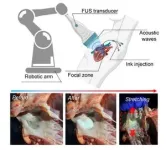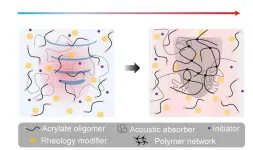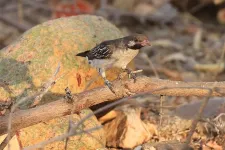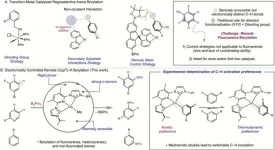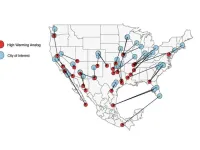(Press-News.org) Embargoed: Not for Release Until 2:00 pm U.S. Eastern Time Thursday, Dec. 7 2023.
Today atmospheric carbon dioxide is at its highest level in at least several million years thanks to widespread combustion of fossil fuels by humans over the past couple centuries.
But where does 419 parts per million (ppm)—the current concentration of the greenhouse gas in the atmosphere—fit in Earth’s history?
That’s a question an international community of scientists, featuring key contributions by University of Utah geologists, is sorting out by examining a plethora of markers in the geologic record that offer clues about the contents of ancient atmospheres. Their initial study was published this week in the journal Science, reconstructing CO2 concentrations going back through the Cenozoic, the era that began with the demise dinosaurs and rise of mammals 66 million years ago.
Glaciers contain air bubbles, providing scientists direct evidence of CO2 levels going back 800,000 years, according to U geology professor Gabe Bowen, one of the study’s corresponding authors. But this record does not extend very deep into the geological past.
“Once you lose the ice cores, you lose direct evidence. You no longer have samples of atmospheric gas that you can analyze,” Bowen said. “So you have to rely on indirect evidence, what we call proxies. And those proxies are tough to work with because they are indirect.”
"Proxies" in the geologic record
These proxies include isotopes in minerals, the morphology of fossilized leaves and other lines of geological evidence that reflect atmospheric chemistry. One of the proxies stems from the foundational discoveries of U geologist Thure Cerling, himself a co-author on the new study, whose past research determined carbon isotopes in ancient soils are indicative of past CO2 levels.
But the strength of these proxies vary and most cover narrow slices of the past. The research team, called the Cenozoic CO2 Proxy Integration Project, or CenCO2PIP, and organized by Columbia University climate scientist Bärbel Hönisch, set out to evaluate, categorize and integrate available proxies to create a high-fidelity record of atmospheric CO2.
“This represents some of the most inclusive and statistically refined approaches to interpreting CO2 over the last 66 million years,” said co-author Dustin Harper, a U postdoctoral researcher in Bowen’s lab. “Some of the new takeaways are we're able to combine multiple proxies from different archives of sediment, whether that's in the ocean or on land, and that really hasn't been done at this scale.”
The new research is a community effort involving some 90 scientists from 16 countries. Funded by dozens of grants from multiple agencies, the group hopes to eventually reconstruct the CO2 record back 540 million years to the dawn of complex life.
At the start of the Industrial Revolution--when humans began burning to coal, then oil and gas to fuel their economies--atmospheric CO2 was around 280 ppm. The heat-trapping gas is released into the air when these fossil fuels burn.
Looking forward, concentrations are expected to climb up to 600 to 1,000 ppm by the year 2100, depending on the rate of future emissions. It is not clear exactly how these future levels will influence the climate.
But having a reliable map of past CO2 levels could help scientists more accurately predict what future climates may look like, according to U biology professor William Anderegg, director the U’s Wilkes Center for Climate & Policy.
"This is an incredibly important synthesis and has implications for future climate change as well, particularly the key processes and components of the Earth system that we need to understand to project the speed and magnitude of climate change,” Anderegg said.
Today's 419 ppm is the highest CO2 in 14 million years
At times in the past when Earth was a far warmer place, levels of CO2 were much higher than now. Still, the 419 ppm recorded today represents a steep and perhaps dangerous spike and is unprecedented in recent geologic history.
“By 8 million years before present, there's maybe a 5% chance that CO2 levels were higher than today,” Bowen said, “but really we have to go back 14 million years before we see levels we think were like today.”
In other words, human activity has significantly altered the atmosphere within the span of a few generations. As a result, climate systems around the globe are showing alarming signs of disruption, such as powerful storms, prolonged drought, deadly heat waves and ocean acidification.
A solid understanding of atmospheric CO2 variation through geological time is also essential to deciphering and learning from various features of Earth’s history. Changes in atmospheric CO2 and climate likely contributed to mass extinctions, as well as evolutionary innovations.
During the Cenozoic, for example, long-term declines in CO2 and associated climate cooling may have driven changes to plant physiology, species competition and dominance, which in turn impacted mammalian evolution.
“A more refined understanding of past trends in CO2 is therefore central to understanding how modern species and ecosystems arose and may fare in the future,” the study states.
END
Geoscientists map changes in atmospheric CO2 over past 66 million years
Carbon dioxide has not been as high as today's concentrations in 14 million years thanks to fossil fuel emissions now warming the planet.
2023-12-07
ELSE PRESS RELEASES FROM THIS DATE:
Ancient stars made extraordinarily heavy elements
2023-12-07
How heavy can an element be? An international team of researchers has found that ancient stars were capable of producing elements with atomic masses greater than 260, heavier than any element on the periodic table found naturally on Earth. The finding deepens our understanding of element formation in stars.
We are, literally, made of star stuff. Stars are element factories, where elements constantly fuse or break apart to create other lighter or heavier elements. When we refer to light or heavy elements, we’re talking about their atomic mass. Broadly speaking, atomic ...
Soundwaves harden 3D-printed treatments in deep tissues
2023-12-07
DURHAM, N.C. -- Engineers at Duke University and Harvard Medical School have developed a bio-compatible ink that solidifies into different 3D shapes and structures by absorbing ultrasound waves. Because it responds to sound waves rather than light, the ink can be used in deep tissues for biomedical purposes ranging from bone healing to heart valve repair.
This work appears on December 7 in the journal Science.
The uses for 3D-printing tools are ever increasing. Printers create prototypes of medical devices, design flexible, ...
Physicists ‘entangle’ individual molecules for the first time, hastening possibilities for quantum information processing
2023-12-07
For the first time, a team of Princeton physicists have been able to link together individual molecules into special states that are quantum mechanically “entangled.” In these bizarre states, the molecules remain correlated with each other—and can interact simultaneously—even if they are miles apart, or indeed, even if they occupy opposite ends of the universe. This research was recently published in the journal Science.
“This is a breakthrough in the world of molecules because of the fundamental importance of quantum entanglement,” said Lawrence Cheuk, assistant professor of physics at Princeton ...
Wild birds lead people to honey — and learn from them
2023-12-07
Key takeaways
People in parts of Africa communicate with a wild bird, the greater honeyguide, to locate bee colonies and harvest their honey and beeswax.
A study by UCLA anthropologist Brian Wood and other authors show how this partnership is maintained and varies across cultures.
They demonstrate the bird’s ability to learn distinct vocal signals traditionally used by different honey-hunting communities.
In parts of Africa, people communicate with a wild bird — the greater honeyguide — in order to locate bee colonies and harvest their stores of honey and beeswax.
It’s a rare example of ...
Evolving trends in cosmetic breast augmentation: New data
2023-12-07
November 30, 2023 – Ongoing quality improvement data submitted by Board-certified plastic surgeons highlight current trends in surgical technique in cosmetic breast augmentation using implants, reports a study in the December issue of Plastic and Reconstructive Surgery®, the official medical journal of the American Society of Plastic Surgeons (ASPS). The journal is published in the Lippincott portfolio by Wolters Kluwer.
"The findings illustrate evolving trends in breast enhancement over the past 16 years, including factors like the location of the incision and the type and positioning of implants," comments lead author Michael J. Stein, ...
Princeton Chemistry develops catalyst for electronically controlled C–H functionalization
2023-12-07
The Chirik Group at the Princeton Department of Chemistry is chipping away at one of the great challenges of metal-catalyzed C–H functionalization with a new method that uses a cobalt catalyst to differentiate between bonds in fluoroarenes, functionalizing them based on their intrinsic electronic properties.
In a paper published this week in Science, researchers show they are able to bypass the need for steric control and directing groups to induce cobalt-catalyzed borylation that is meta-selective.
The lab’s research ...
Llama power: Tiny llama nanobodies neutralize different noroviruses. Can they improve human anti-viral therapies?
2023-12-07
Human noroviruses cause acute gastroenteritis, a global health problem for which there are no vaccines or antiviral drugs. Although most healthy patients recover completely from the infection, norovirus can be life-threatening in infants, the elderly and people with underlying diseases. Estimates indicate that human noroviruses cause approximately 684 million illnesses and 212,000 deaths annually.
“Human noroviruses are highly diverse,” said first author Dr. Wilhelm Salmen, a graduate student in Dr. B V Venkataram Prasad’s lab while he was working ...
Less ice on the road leads to more salt in the soil, air, and water
2023-12-07
When temperatures drop and roads get slick, rock salt is an important safety precaution used by individuals, businesses, and local and state governments to keep walkers, cyclists, and drivers safe. However, according to a new scientific review paper from a team of researchers at Virginia Tech and the University of Maryland, the human demand for salt comes at a cost to the environment.
Published in the journal Nature Reviews Earth & Environment with researchers Stanley Grant, Megan Rippy, and Shantanu Bhide from Virginia Tech’s Occoquan Watershed Monitoring Laboratory, ...
Very early treatment of newborns with HIV could result in medication-free remission for many babies
2023-12-07
An unexpectedly high percentage of children, who were born with HIV and started treatment within 48 hours of life, exhibit biomarkers by 2 years of age that may make them eligible to test for medication-free remission, according to a multinational study published in Lancet HIV.
“Moving away from reliance on daily antiretroviral therapy (ART) to control HIV would be a huge improvement to the quality of life of these children,” said Protocol Co-Chair and senior author Ellen Chadwick, MD, former Director of Section ...
Sister climate cities, utility data predict future water, electricity demands
2023-12-07
UNIVERSITY PARK, Pa. – Modern-day Ciudad Mante, Mexico, could help Tampa, Florida, plan for shifting water and electricity demands due to climate change, according to an international team of researchers. Led by Renee Obringer, assistant professor of energy and mineral engineering at Penn State, the researchers used utilities data and climate analogs — contemporary cities with climates close to what other cities are predicted to experience in the future — to assess how climate change may impact residential water and electricity use across 46 cities in the United States.
Their computationally efficient model projected strong regional differences for future water and electricity ...
LAST 30 PRESS RELEASES:
Researchers find promising new way to boost the immune response to cancer
Coffee as a staining agent substitute in electron microscopy
Revealing the diversity of olfactory receptors in hagfish and its implications for early vertebrate evolution
Development of an ultrasonic sensor capable of cuffless, non-invasive blood pressure measurement
Longer treatment with medications for opioid use disorder is associated with greater probability of survival
Strategy over morality can help conservation campaigns reduce ivory demand, research shows
Rising temperatures reshape microbial carbon cycling during animal carcass decomposition in water
Achieving ultra-low-power explosive jumps via locust bio-hybrid muscle actuators
Plant-derived phenolic acids revive the power of tetracycline against drug-resistant bacteria
Cooperation: A costly affair in bacterial social behaviour?
Viruses in wastewater: Silent drivers of pollution removal and antibiotic resistance
Sub-iethal water disinfection may accelerate the spread of antibiotic resistance
Three in four new Australian moms struggle with body image
Post-stroke injection protects the brain in preclinical study
Cardiovascular risk score predicts multiple eye diseases
Health: estimated one in ten British adults used or interested in GLP-1 medications for weight loss
Exercise to treat depression yields similar results to therapy
Whooping cough vaccination for pregnant women strengthens babies’ immune system
Dramatic decline in new cases of orphanhood in Uganda driven by HIV treatment and prevention programs
Stopping weight loss drugs linked to weight regain and reversal of heart health markers
Higher intake of food preservatives linked to increased cancer risk
Mass General Brigham–developed cholera vaccine completes phase 1 trial
First experimental validation of a “150-year-old chemical common sense” direct visualization of the molecular structural changes in the ultrafast anthracene [4+4] photocycloaddition reaction
Lack of support for people on weight loss drugs leaves them vulnerable to nutritional deficiencies, say experts
Dogs’ dinners can have greater climate impact than owners’
Are you ready to swap salmon for sprats and sardines?
1.6 million UK adults used weight loss drugs in past year
American College of Cardiology comments on new dietary guidelines for Americans
American Society of Gene & Cell Therapy and Orphan Therapeutics Accelerator partner to advance and commercialize promising rare disease treatments
One in 14 patients having day case surgery have new or worse chronic pain 3 months after their operation
[Press-News.org] Geoscientists map changes in atmospheric CO2 over past 66 million yearsCarbon dioxide has not been as high as today's concentrations in 14 million years thanks to fossil fuel emissions now warming the planet.

